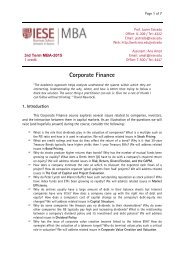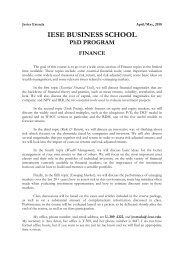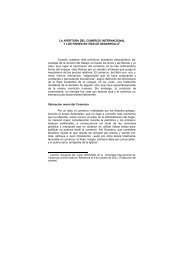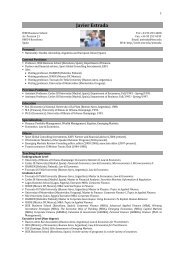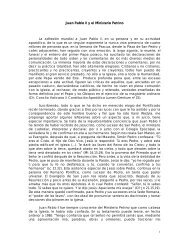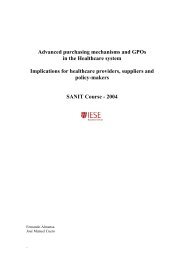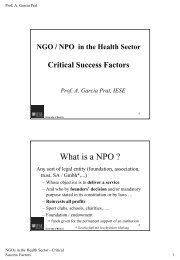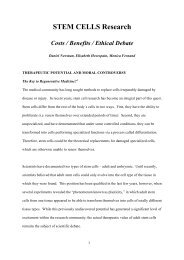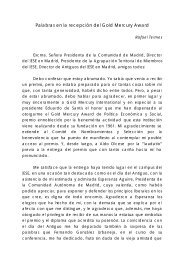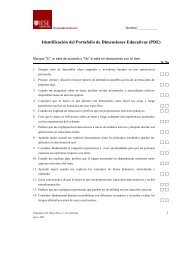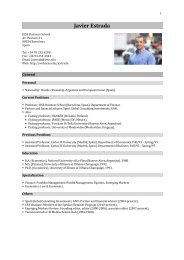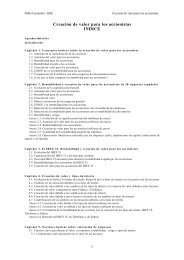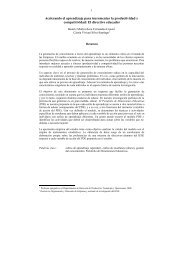PER, crecimiento y rentabilidad de una empresa
PER, crecimiento y rentabilidad de una empresa
PER, crecimiento y rentabilidad de una empresa
You also want an ePaper? Increase the reach of your titles
YUMPU automatically turns print PDFs into web optimized ePapers that Google loves.
➧<br />
<strong>crecimiento</strong>)<br />
Supongamos, sin embargo que el<br />
precio por acción <strong>de</strong> Telefónica<br />
<strong>de</strong>l 26 <strong>de</strong> noviembre <strong>de</strong> 1997 fue<br />
4.275 pesetas. El beneficio por<br />
acción <strong>de</strong>l año 1996 fue 170 pesetas.<br />
Si la <strong>rentabilidad</strong> exigida a las<br />
acciones era 10%, el precio <strong>de</strong> la<br />
acción <strong>de</strong> Telefónica sin <strong>crecimiento</strong><br />
fue 1.700 pesetas<br />
(170/0,1), y el valor <strong>de</strong>l <strong>crecimiento</strong><br />
fue 2.575 (4.275 -1.700),<br />
en tal caso un 40% (1.700/4.275)<br />
<strong>de</strong>l valor <strong>de</strong> la acción <strong>de</strong> Telefónica<br />
se <strong>de</strong>bía al beneficio ya conseguido<br />
por la <strong>empresa</strong> (P sin <strong>crecimiento</strong>)<br />
y un 60% (2.575 /4.275)<br />
se <strong>de</strong>bía al <strong>crecimiento</strong> esperado<br />
(valor <strong>de</strong>l <strong>crecimiento</strong>)<br />
Como referencia, cabe apuntar<br />
que en noviembre <strong>de</strong> 1997, en<br />
media, un 44% <strong>de</strong>l valor <strong>de</strong> las<br />
<strong>empresa</strong>s que componían el IBEX<br />
35 se <strong>de</strong>bía al beneficio ya conseguido<br />
por las <strong>empresa</strong>s (P sin <strong>crecimiento</strong>)<br />
y un 56% se <strong>de</strong>bía al<br />
<strong>crecimiento</strong> esperado (valor <strong>de</strong>l<br />
<strong>crecimiento</strong>).<br />
Po<strong>de</strong>mos hacer esta misma <strong>de</strong>scomposición<br />
con el <strong>PER</strong> y consi<strong>de</strong>rarlo<br />
como la suma <strong>de</strong>l <strong>PER</strong><br />
que tendría la <strong>empresa</strong> si no creciera<br />
más el <strong>PER</strong> incremental <strong>de</strong>bido<br />
al <strong>crecimiento</strong>.<br />
<strong>PER</strong>=<strong>PER</strong>sin <strong>crecimiento</strong>+<strong>PER</strong><strong>crecimiento</strong><br />
Como el <strong>PER</strong> es el precio por acción<br />
dividido por el beneficio por<br />
acción, resulta:<br />
<strong>PER</strong> sin <strong>crecimiento</strong>=1/ <strong>rentabilidad</strong> exigida a<br />
las acciones<br />
<strong>PER</strong><strong>crecimiento</strong>=valor <strong>de</strong>l <strong>crecimiento</strong> / beneficio<br />
por acción<br />
■ <strong>PER</strong>, FRANCHISE FACTOR<br />
Y FACTOR CRECIMIENTO<br />
40<br />
T E M A S D E A C T U A L I D A D<br />
El <strong>PER</strong> se pue<strong>de</strong> <strong>de</strong>scomponer en<br />
dos sumandos <strong>de</strong>l siguiente modo:<br />
I<br />
<strong>PER</strong>= —— + FF x G<br />
Ke<br />
ROE-Ke<br />
FF= –– –––––––––<br />
ROE Ke<br />
g<br />
G= –<br />
Ke-g<br />
El primer sumando, 1/Ke (en<br />
nuestro caso 1/10% = 10), es el<br />
<strong>PER</strong> <strong>de</strong> la <strong>empresa</strong> si no crece, sea<br />
cual sea la <strong>rentabilidad</strong> <strong>de</strong> sus inversiones.<br />
El segundo sumando (FF x G) es<br />
◆◆◆<br />
la contribución <strong>de</strong>l <strong>crecimiento</strong> al<br />
El franchise factor mi<strong>de</strong> lo que<br />
podríamos llamar la “calidad” <strong>de</strong>l<br />
<strong>crecimiento</strong>, entendiendo por “calidad”<br />
<strong>rentabilidad</strong> por encima <strong>de</strong>l<br />
coste <strong>de</strong> los recursos empleados<br />
◆◆◆<br />
<strong>PER</strong>. Se compone <strong>de</strong> dos factores:<br />
- el factor <strong>crecimiento</strong> G, que <strong>de</strong>pen<strong>de</strong><br />
fundamentalmente <strong>de</strong>l <strong>crecimiento</strong><br />
<strong>de</strong> la <strong>empresa</strong>.<br />
- el franchise factor FF, que <strong>de</strong>pen<strong>de</strong><br />
principalmente <strong>de</strong> la diferencia<br />
entre <strong>rentabilidad</strong> <strong>de</strong> las inversiones<br />
y el coste <strong>de</strong> los recursos<br />
empleados. El franchise factor mi<strong>de</strong><br />
lo que podríamos llamar la “calidad”<br />
<strong>de</strong>l <strong>crecimiento</strong>, entendiendo<br />
por “calidad” <strong>rentabilidad</strong> por<br />
encima <strong>de</strong>l coste <strong>de</strong> los recursos<br />
empleados.<br />
Esta fórmula nos indica que el<br />
<strong>PER</strong> <strong>de</strong> <strong>una</strong> <strong>empresa</strong> es el <strong>PER</strong> <strong>de</strong><br />
la <strong>empresa</strong> sin <strong>crecimiento</strong> más<br />
un “<strong>PER</strong> extra” <strong>de</strong>bido al creci-<br />
Nº 80, AGOSTO-SEPTIEMBRE 1999



